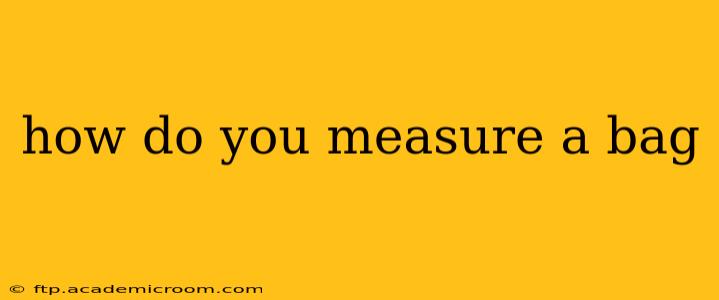How Do You Measure a Bag? The Complete Guide to Bag Dimensions
Measuring a bag accurately is crucial for various reasons, from ensuring it fits your needs and desired items to comparing sizes when shopping online or selling pre-owned bags. This comprehensive guide outlines the different methods and considerations for measuring your bags.
What are the standard measurements for bags?
The standard measurements for bags generally include length, width, and height. Sometimes, additional measurements like depth, strap length, and handle drop are also important, depending on the bag style and your intended use. Understanding these dimensions will help you accurately assess a bag's capacity and suitability.
What tools do I need to measure a bag?
You'll primarily need a flexible measuring tape or a ruler. For larger bags, a longer measuring tape is advantageous. A pen and paper (or a digital notepad) will help you record your measurements.
How do I measure the length, width, and height of a bag?
-
Lay the bag flat on a surface: Ensure the bag is lying flat and uncrumpled to obtain accurate measurements.
-
Measure the length: This is the longest horizontal measurement of the bag, usually taken along the bottom or widest part.
-
Measure the width: This is the measurement from side to side, usually at the widest point of the bag.
-
Measure the height: This is the measurement from the bottom of the bag to the top, usually taken while the bag is upright.
Important Note: For structured bags, measuring along the bottom and sides provides the most accurate dimensions. For unstructured or flexible bags, the measurements might vary slightly depending on how full the bag is. It's advisable to measure an empty bag for consistency.
How do I measure the depth of a bag?
Depth refers to the bag's thickness or how far the contents extend from the back panel to the front. Measure this by placing the measuring tape from the front to the back panel, ensuring it lies flat against the bag.
How do I measure the strap length and handle drop?
These measurements become especially crucial for bags with straps or handles.
- Strap Length: Measure the entire length of the strap from end to end, fully extended.
- Handle Drop: This is the distance from the top of the bag's handle to where the handle attaches to the bag. This indicates how long the handle will be when the bag is being carried.
What are the best practices for measuring a bag consistently?
- Consistency: Always measure in the same way for accurate comparisons.
- Units: Use a consistent unit of measurement (inches or centimeters) throughout.
- Multiple measurements: Take multiple measurements at different points and average them for greater accuracy, especially with less structured bags.
- Clarity: When describing your measurements online or in a listing, provide clear details (e.g., "Length: 12 inches, Width: 8 inches, Height: 10 inches"). Include the method of measurement if relevant (e.g., "measured at the bottom," "measured while lying flat").
By following these steps, you can accurately measure any bag and ensure a perfect fit for your belongings or find the ideal bag for your needs. Remember, precise measurements are key, especially when shopping online.
